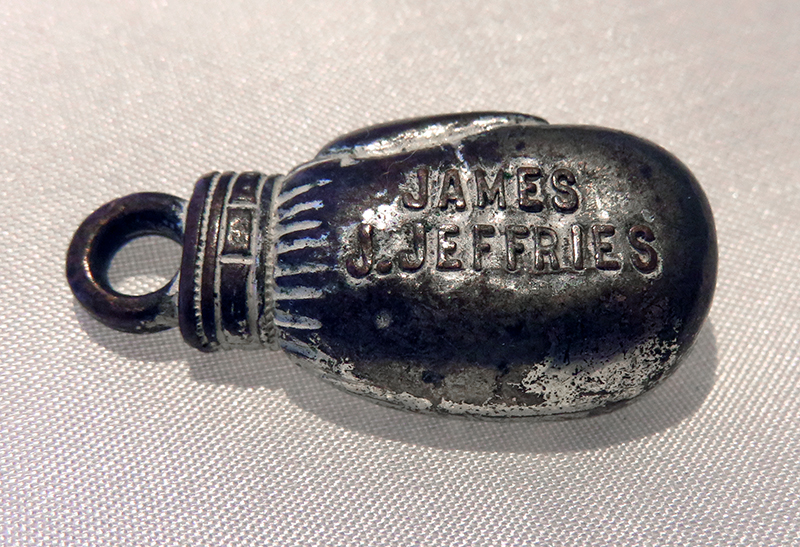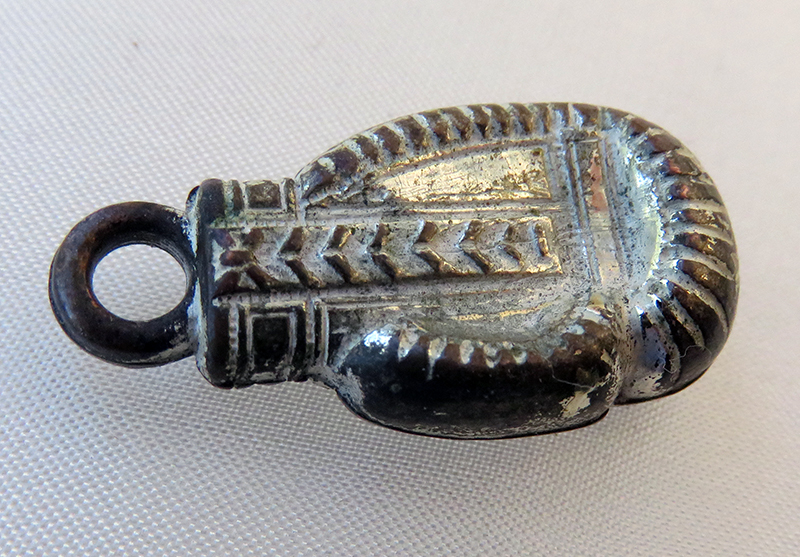|
|


Click image to enlarge.
James J. Jeffries boxing glove charm, gumball prize, ~1950s. Indeterminate metal, 1 inch total length (24.8 x 12.6 x 6.7 mm), virtually weightless. Jeffries was heavyweight champion of the world from 1899-1904. His boxing career stretched from 1896-1910. Afterward, during World War I, he became the first person known to have manufactured gunpowder in the Santa Clarita Valley — on land that would eventually become home to the Bermite Powder Company. This charm was thought to be a Cracker Jack prize when it was acquired (Cracker Jack began in 1896 and started inserting prizes in 1912.) However, according to Larry White, who literally wrote the book on Cracker Jack prizes ("Cracker Jack Toys: The Complete, Unofficial Guide for Collectors," 1997), it is a gumball prize. He writes: "What you have is a gumball prize from the 1950s or so. It is common to get the gumball prizes confused with Cracker Jack prizes, and there was some overlap of a prize being both — but this is not one of those" (email, August 8, 2019). Gumball prizes reportedly started in 1936 when inventor Samuel Eppy, who was working for Gum Inc., once the nation's largest chewing gum manufacturer, inserted a prize with each gumball in a toy capsule. This evolved into prizes getting their own vending machine capsule. So, a date in the 1950s for this boxing glove charm is plausible, even though Jeffries' boxing career had been over for decades by that time (and he died in 1953). There are many examples of similiar boxing glove charms bearing the names of other early pugilists.
About James J. Jeffries. Pugilist James J. Jeffries was the earliest known predecessor to the Bermite Powder Co. in Saugus. Nicknamed the Boilermaker, Jeffries (1875-1953) was the heavyweight champion of the world from 1899-1904. He seized the title with an 11th-round knockout of reigning champion Bob Fitzsimmons in Brooklyn on June 9, 1899. He defended his title seven times, including rematches with Fitzsimmons and Tom Sharkey, and two challenges from Gentleman Jim Corbett. Jeffries was one of the few prizefighters to go out on top when he retired in May 1905. But then he made the fateful decision in 1910 to try a comeback against then-heavyweight champion Jack Johnson. Jeffries, now 35, was billed as the "Great White Hope" in this hugely promoted bout. He was knocked unconscious in the 15th round by Johnson, who was black. It was the only loss of Jeffries' career, which counted 18 wins, 15 of them by a knockout, and 2 draws. Afterward, Jeffries tried his luck at several business ventures. He owned a bar and a farm in Burbank where he bred prize cattle. In 1917, as the United States was entering World War I, James and his brother Jack were the heads of the new Los Angeles Gunpowder Co. and possessors of a secret formula of high-grade gunpowder that they were manufacturing in Saugus. "The plant at Saugus was established about nine months ago," brother Jack told reporters in March 1918. "We are using material dug out of the hills, and the result is a splendid grade of smokeless powder." It was reportedly suitable for "shotgun shells or other forms of ammunition requiring a bulk powder." By 1920, the Boilermaker had dug exploratory oil wells on the Saugus property he had purchased "several years earlier," according to reports. However, it appears none of these ventures paid off. The armistice of November 11, 1918, curtailed the need for gunpowder, and there is no indication the oil wells produced. In 1923 Jeffries filed for bankruptcy protection, reporting assets of $130,000 and liabilities of $192,000.* His Burbank ranch was split up to pay off his debtors, and for a time, he went on tour with his old rival Tom Sharkey as a pair of vaudeville fighters before returning to what was left of his ranch. In later years he would train amateur fighters. Jim Corbett echoed the sentiments of many contemporaries when he opined that James Jeffries' speed, strength and size (225 pounds) made him "the greatest heavyweight champion of them all." As for Jeffries' Saugus property, oilman E.P. Halliburton and partners picked up the ball in 1934 when they formed the Halafax Explosives Co. and set up a big, new manufacturing plant that opened in April 1935. Four years later, Patrick Lizza established Golden State Fireworks on adjacent property, while Halafax manufactured fireworks at its site from 1936 to 1942. Halafax eventually defaulted on its property taxes, and Lizza's company, as Bermite Powder, acquired the land and used it to manufacture military ordnance and other explosives until 1987 (after 1967 as Whittaker-Bermite). The combined 996-acre property is bounded by the Circle J community on the south, Bouquet Canyon Road on the west, Soledad Canyon Road on the north, and Golden Valley Road on the east. * Death notice in Sunday Herald, Sydney, Australia, March 8, 1953.
LW3597: 9600 dpi jpeg from original toy purchased 2019 by Leon Worden; collection of Jessica Boyer (online only).
|
The site owner makes no assertions as to ownership of any original copyrights to digitized images. However, these images are intended for Personal or Research use only. Any other kind of use, including but not limited to commercial or scholarly publication in any medium or format, public exhibition, or use online or in a web site, may be subject to additional restrictions including but not limited to the copyrights held by parties other than the site owner. USERS ARE SOLELY RESPONSIBLE for determining the existence of such rights and for obtaining any permissions and/or paying associated fees necessary for the proposed use.








